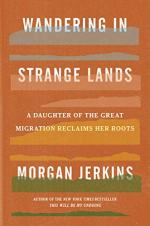|
This section contains 562 words (approx. 2 pages at 400 words per page) |

|
Wandering in Strange Lands Summary & Study Guide Description
Wandering in Strange Lands Summary & Study Guide includes comprehensive information and analysis to help you understand the book. This study guide contains the following sections:
This detailed literature summary also contains Topics for Discussion on Wandering in Strange Lands by Morgan Jerkins.
The following version of this book was used to create this study guide: Jerkins, Morgan. Wandering in Strange Lands: A Daughter of the Great Migration Reclaims Her Roots. New York: HarperCollins, 2020.
In the book’s prologue, author Morgan Jerkins writes about her parents, one of whom is from the New Jersey, and one of whom is from the North Carolina. Morgan Jerkins is a writer who focuses on Black American history, and she is interested in exploring her genealogical heritage, with the larger goal of understanding Black American history more fully. In researching this book, Jerkins traveled to various locations around the United States that have salient connections to the relevant history.
The book’s first part focuses on the geographical region known as the Lowcountry, which covers parts of Georgia and parts of South Carolina. The Lowcountry is home to many Gullah Geechee people. Gullah Geechee is a specific ethnic group of people descended from West African people who were forcibly brought to the United States as slaves. Jerkins observed that Gullah Geechee communities are continually threatened with dispersal due to the economic encroachment of corporations and wealthy white people. As a result of these encroachments, Gullah Geechee communities are shrinking and becoming more dispersed, and thus Gullah Geechee culture is becoming less stable and concentrated.
The book’s second section focuses on Louisiana, where there are substantial populations of the ethnic group known as Creole. Creole people are descended from African and French settlers. Prior to Louisiana becoming an American territory, Creole people faced less discrimination, and many of them even had substantial wealth. Under American society, Creole people are generally viewed as synonymous with all other Black ethnic groups, and as such, they face similar oppression and discrimination. Jerkins explores Creole heritage and history in order to further challenge concepts of race and racism in the United States.
The book’s third section focuses on Oklahoma. In the 1800s, the U.S. forcibly relocated over 100,000 Native Americans to the Oklahoma territory. This event became known as the Trail of Tears, as many Native Americans died along the way. There were also many free and enslaved Black people who were forced into this relocation. Jerkins illustrates various factors that have caused historical intermingling between native Americans and Black Americans. However, due to dynamics of racism and forced racial divisions, the documentation showing these genealogical intersections has often been destroyed or manipulated.
The book’s fourth section focuses on Los Angeles. Over the decades, many Black Americans relocated to Los Angeles in search of new opportunities, and in an effort to escape racial discrimination. However, Black Americans in Los Angeles—and in America’s other major cities—have faced consistent forms of egregious oppression, including violent oppression enacted by police forces. Black Americans formed street gangs in an effort to protect themselves and their neighborhoods from police. However, continued police aggression eventually fractured these gangs and compelled them to turn against each other. Black communities in U.S. cities continue be underserved and over-policed.
In the book’s epilogue, Jerkins urges the reader to pay heed to all of the information in the book about racial oppression, as well as the information pertaining to the genealogical connections between all Black communities in the United States. Ultimately, solidarity between Black communities will help to strengthen the movement for social justice.
Read more from the Study Guide
|
This section contains 562 words (approx. 2 pages at 400 words per page) |

|



